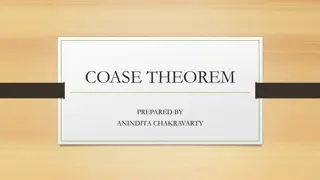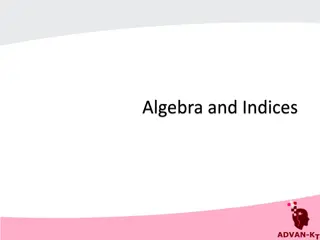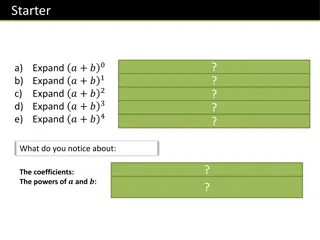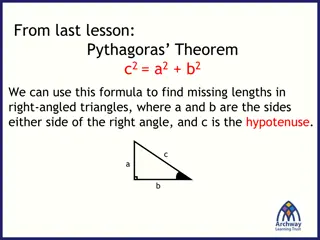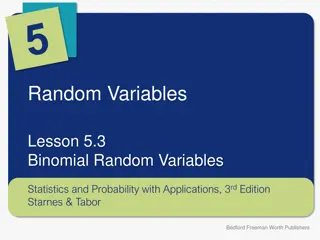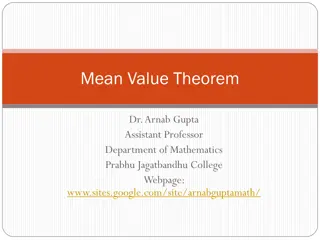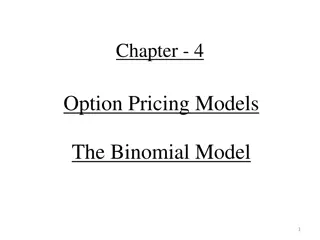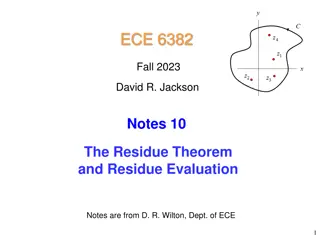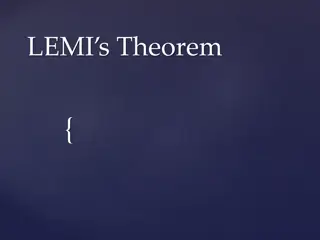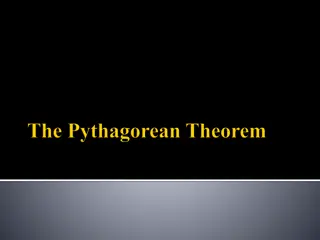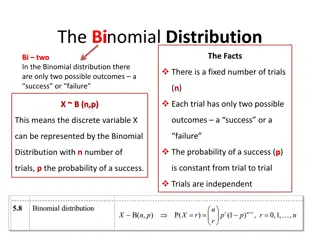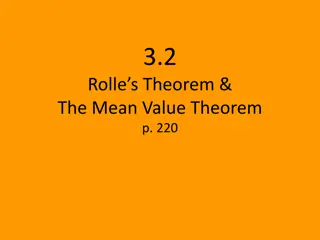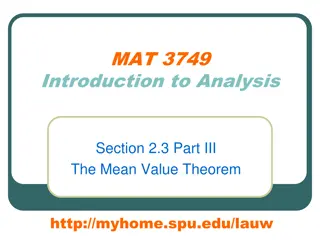Understanding Binomial Theorem in Mathematics
Explore the Binomial Theorem in mathematics, covering Pascal's Triangle, binomial expansions, coefficients, general terms, and more. Learn how to expand binomials, analyze powers, find approximate numbers, and determine middle terms. Discover the structure of Pascal's Triangle and apply it to expand binomials. Dive into examples to expand binomials using Pascal's Triangle and understand the coefficients involved.
Download Presentation

Please find below an Image/Link to download the presentation.
The content on the website is provided AS IS for your information and personal use only. It may not be sold, licensed, or shared on other websites without obtaining consent from the author. Download presentation by click this link. If you encounter any issues during the download, it is possible that the publisher has removed the file from their server.
E N D
Presentation Transcript
CLASS-XI SUB-MATHEMATICS TOPIC-BINOMIAL THEOREM
Binomial Theorem Learning Objectives The students will be able to Remember the structure of Pascal's Triangle Remember Binomial theorem Understood how to expand (a+b)n Apply formula for Computing binomial coefficients
Analyze powers of a binomial by Pascal's Triangle and by binomial coefficients. Find approximate of numbers using binomial expansions. Find General term of any binomial expansion Find middle term of binomial expansion Design the formula how to find nth term from end
Binomial Theorem Let s look at the expansion of (x + y)n (x + y)0 = 1 (x + y)1 = x + y (x + y)2 = x2 +2xy + y2 (x + y)3 = x3 + 3x2y + 3xy2 + y3 (x + y)4 = x4 + 4x3y + 6x2y2 + 4xy3 + y4
Expanding a binomial using Pascals Triangle Pascal s Triangle 1 1 1 1 2 1 1 3 3 1 1 4 6 4 1 1 5 10 10 5 1 1 6 15 20 15 6 1 Write the next row.
From the above we observe that the addition of 1s in the row for index 1 gives rise to 2 in the row for index 2. The addition of 1,2 and 2,1in the row for index 2,gives rise to 3 and 3 in the row for index 3 and so on. Also ,1 is present at the beginning and at the end of each row.
The structure looks like a triangle with 1 at the top vertex and running and running down the slanting sides. This array of numbers is known as Pascal s triangle. After the name of French mathematician Blaise Pascal.
Example -1. Expand (x + 3)4 Solution: From Pascal s triangle write down the 4th row. 1 4 6 4 1 These numbers are the same numbers that are the coefficients of the binomial expansion.
The expansion of (a + b)4 is: 1a4b0 + 4a3b1 + 6a2b2 + 4a1b3 + 1a0b4 Notice that the exponents always add up to 4 with the a s going in descending order and the b s in ascending order. Now substitute x in for a and 3 in for b. x4 + 4x3(3)1 + 6x2(3)2 + 4x(3)3 + 34 This simplifies to x4 + 12x3 + 54x2 + 108x + 81
Example 2. Expand (x 2y)4 Solution:This time substitute x in for a and -2y for b. x4 + 4x3(-2y)1 + 6x2(-2y)2 + 4x(-2y)3 + (-2y)4 The final answer is: x4 8x3y + 24x2y2 32xy3 + 16y4
In the Pascal triangle , For index 0; the entry of row is 1= 0C0 For index 1; the entries of row are 1= 1C0 and 1=1C1 For index 2; the entries of row are ,1=2C0 , 2= 2C1, 1= 2C2 For index 3; the entries of row are ,1=3C0, 3=3C1, 3=3C2, 1= 3C3
For index 4 ; the entries of row are ,1= 4C0, 4=4C1, 6= 4C2, 4= 4C3, 1= 4C4 And so on So, now we can write For index 5, the entries of row are 5C0, 5C1, 5C2, 5C3, 5C4, 5C5 For index 6, the entries of row are 6C0, 6C1, 6C2, 6C3, 6C4, 6C5, 6C6
For index 7, the entries of row are 7C0, 7C1, 7C2, 7C3, 7C4, 7C5, 7C6, 7C6 Hence (a+b)n=7C0a7 + 7C1a6b + 7C2 a5b2 + 7C3 a4b3+ 7C4 a3b4 + 7C5 a2b5 + 7C6 ab6 + 7C6 b7 Now we can write the expansion of a binomial for any positive integral index
Binomial theorem for any positive integer n (a + b )n = nC0an + nC1an-1b + nC2an-2b2 + + nCn-1abn-1+ nCn bn Proof: This can be proved by applying principle of mathematical induction. Let the given statement be P(n): (a + b )n = nC0an + nC1an-1b + nC2an-2b2 + + nCn-1abn-1+ nCn bn
For n=1,we have (a+b)1= 1C0a1 + 1C1b1=a+b So, P(1) is true. Assume that P(k) is true for some positive integer k i.e (a + b )k = kC0ak + kC1ak-1b + kC2ak-2b2+ + kCk bk (1)
To prove that P(k+1) is true i.e to prove that ; (a + b )k+1 = k+1C0ak+1 + k+1C1akb + k+1C2ak-1b2+ + k+1Ck+1 bk+1 LHS=(a + b )k+1 =(a+b) (a + b )k =(a+b)( kC0ak + kC1ak-1b + kC2ak-2b2+ + kCk bk) (By equation 1)
= kC0ak+1 + kC1akb + kC2ak-1b2+ + kCkabk + kC0akb + kC1ak-1b2 + kC2ak-2b3+ + kCk bk+1 = kC0ak+1+( kC1+ kC0) akb+ ( kC2+ kC1)ak-1b2+ +(kCk+kCk-1) abk+ kCk bk+1 = k+1C0ak+1 + k+1C1akb + k+1C2ak-1b2+ + k+1Ckabk + k+1Ck+1 bk+1 ( By using k+1C0=1= kC0 , kCr+ kCr-1= k+1Cr and kCk=1= k+1Ck+1)
=RHS So, P(k+1) is true. Hence by method of induction P(n) is true for all positive integer n i.e (a + b )n = nC0an + nC1an-1b + nC2an-2b2 + + nCn-1abn-1+ nCn bn
Example 3 Expand (2x+3y)4 by binomial theorem. Solution: (2x+3y)4 = 4C0 (2x)4 (3y)0 + 4C1 (2x)3 (3y)1+4C2 (2x)2 (3y)2 +4C3 (2x)1 (3y)3 +4C4 (2x)0 (3y)4 =16x4+4(8x3)3y+6(4x2)(9y2)+4(2x)(27y3)+81y4 = 16x4+96x3y+216x2y2+216xy3+81y4
Observations: 2.The coefficient nCr occurring in the binomial theorem are known as binomial coefficients. 3.There are (n+1) terms in the expansion of (a+b)n 4.In the successive terms of the expansion the index of a goes on decreasing by unity. At the same time the index of b increases by unity.
5. In the expansion of (a+b)n ,the sum of indices of a and b is n+0=n in the first term,(n-1)+1=n in the second term and so on 0+n=n in the last term. Thus it can be seen that the sum of the indices of a and b is n in every term of the expansion.
Example 4: Compute (98)5 , using Binomial theorem. = 5C0(100)5 --5C1(100)4.2 + 5C2(100)3.22-- 5C3(100)2.23+5C4(100).24+5C5(100)0.25 = 10000000000 -5.100000000.2+ 10.1000000.4 - 10.10000.8 +5.100.16 - 32 =10040008000 - 1000800032 =9039207968
General trem of Binomial expansion (r+1) th term of Binomial expansion = Tr+1= nCran-rbr = 20C6 36x2
Example 6: Solution: Tr+1= 9Crx9-r(2y)r = 9Cr .2r.x9-r.yr
Example 7: Find the rth term from the end in the expansion of (x+a)n Solution: There are (n+1) terms in the expansion of (x+a)n i.e T1, T2, T3, T4, .., Tn-1, Tn, Tn+1 So, first term from end is the (n+1)th term from beginning and n+1= (n+1)-(1-1)
Second term from end is (n+1)-(2-1)=nth term from beginning Third term from end is the (n+1)-(3-1) = (n-1)th term from beginning and so on Similarly, rth term from end is (n+1)-(r-1)=(n-r+2)th term from beginning. Hence required rth term from end = Tn-r+2= nCn-r+1xr-1an-r+1.
SUMMARY (a + b )n = nC0an + nC1an-1b + nC2an-2b2 + + nCn-1abn-1+ nCn bn General term Tr+1= nCran-rbr
rth term from the end in the expansion of (a+b)n =(n-r+2)th term from beginning.





